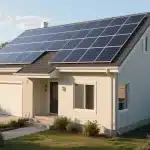how does solar energy work diagram step by step
I’m going to use some solar panel diagrams to show you how solar cells work and then describe all of the elements that go up to make a complete home solar system.Creating a step-by-step diagrams of how solar energy works involves illustrating the process from sunlight hitting the solar panels to the generation of usable electricity. Below is a description of each step involved in this process:

How a photovoltaic cell works

The diagram above gives us a more detailed look at what happens inside a solar cell. The solar cell contains two separate discs of silicon sandwiched closely together. These silicon discs are doped or specially treated to give them an electrical charge.
The N-type silicon on the top level of the disc has an excess of electrons (negative charge), and the P-type silicon underneath has a deficiency of electrons (positive charge). The N-type silicon on the top level of the disc has a positive charge, and the P-type silicon underneath has a negative charge.
When no light is shining on a PV cell, the differently charged positive and negative discs of silicon create a barrier between each other, and electricity can’t flow between them.
But when photons from the sun hit the silicon discs, something special happens. When photons from the sun hit the silicon discs, they impart energy to the electrons in the P-type silicon, enabling them to move into the N-type layer. This movement of electrons creates an electrical current. This photoelectric effect is what produces electricity in a solar cell.
The parts of a solar PV system

The diagram above is a good representation of the individual components that make up a home solar PV system. Let’s look at what all of these elements do and then see how everything connects.
Solar Cell to Solar Array
solar modules are sealed units that contain either sixty or seventy-two solar cells. These are carefully mounted and sealed to protect them from the elements and allow them to produce electricity for around twenty-five years. Several solar modules are connected to create a solar panel, and then several solar panels are connected to form a complete solar array.
Note that solar modules are more often called solar panels. Even though a solar panel is a collection of several solar cells, you will find that the term solar panel, or solar module, is often used interchangeably to describe a unit of several solar cells.
Cabling
the different elements of a solar system are connected by cabling to transfer electricity. Cables are made from either copper or cheaper and less efficient aluminum. Because exterior cables are exposed to extremes of weather and temperature, their casing is made from special moisture and heat-resistant thermoplastic (THWN)
Wire solar panels in series
Put it simply, we are all very familiar with traditional batteries. A solar panel is just a comparable model that has two poles too. It has a positive terminal and a negative terminal. Wiring solar panels in series to connect each of them to the other in order. And finally, they form a panel line.
If you have a wiring diagram, you can do it as the diagram shows: you should connect the wire from the positive terminal of one solar panel to the negative terminal of the next solar panel, and repeat. Finally, all of them will be connected in series.

DC Isolator
A DC isolator is an important safety component of a home solar system. It is simply a switch that disconnects the solar array from the electricity network for servicing and maintenance.
Generation Meter
Generation meters show us how much electricity is being produced by the solar array. These provide valuable information that we can use to monitor the performance of our solar system and calculate precisely how much power our panels are generating.
Charge Controller (not essential)
We use a charge controller in solar systems that have battery storage. It monitors the current going into the batteries from the solar panels and ensures that the batteries don’t overcharge.
Battery (not essential)
Batteries are one of the ways that your home solar system stores the electricity it generates. Batteries are used in off-grid solar systems where they are the only storage mechanism for solar electricity. We charge the batteries with solar electricity and then use them to power devices in the home.

On-grid solar systems often don’t include batteries because the solar system connects to your main electricity supply. However, batteries can be added to provide backup power in case of grid outages. Electricity is transferred backward and forwards through this network connection so any excess electricity you generate is made available to the grid as a whole.
Hopefully, these diagrams have given you a clearer understanding of how solar systems work and the individual elements that make them up. If you are considering solar energy for your home or business, it might be helpful to understand the pros and cons of solar energy. If you have any questions, comments, or suggestions, please share them with us below.










